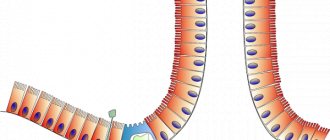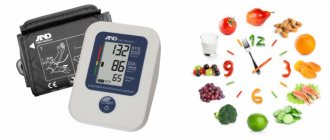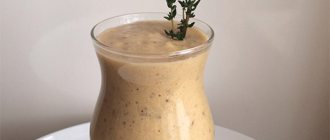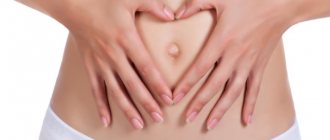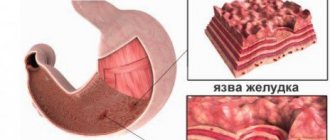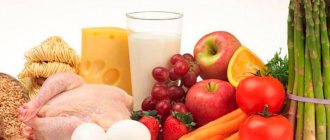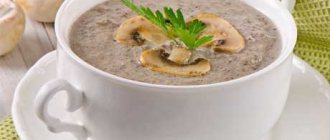Diet for illness
The disease is characterized by a chronic course, which is accompanied by inflammation of the mucous membrane of the colon with subsequent disruption of integrity in the form of erosions and ulcers. Treatment includes the use of anti-inflammatory drugs and glucocorticosteroid hormones. Regardless of the severity of the pathology, as well as the prevalence of changes in the mucous membrane, a diet must be prescribed. In a hospital or at home, table 4 according to Pevzner is used (Pevzner is a general practitioner who developed therapeutic and preventive dietary tables for various disease groups; they have numbers from 0 to 15).
Diet 4 involves excluding from the diet foods that provoke fermentation and putrefaction in the intestines. This helps achieve several therapeutic goals:
- Reducing the load on all parts of the digestive system, including the colon. The result is a decrease in the severity of enteral diarrhea with normalization of stool.
- Creating conditions for reducing the severity of the inflammatory reaction in the mucous membrane, as well as restoring tissue in the area of loss of integrity.
- Slowing of peristalsis (wave-like movements of the intestinal walls aimed at pushing the contents) of the intestines.
To improve the condition of the digestive system, it is important to systematically apply dietary recommendations.
General rules
Using a diet involves including certain foods in the diet, limiting or eliminating various dishes, as well as following the following general rules:
- Drawing up a list of permitted and prohibited foods.
- Reducing the amount of fats and carbohydrates in the daily diet against the background of an increase in the intake of protein compounds, which are synthetic material for tissue repair.
- Providing fractional nutrition, you need to eat often, but not much.
- Food should be boiled in water or steamed.
- The optimal temperature for food is +37°C.
- Table salt (sodium chloride) should not exceed 10 g per day.
- The volume of incoming liquid is about 1.5-2 liters per day.
- The amount of plant fiber in the daily diet is limited, as it can provoke mechanical irritation of the mucous membrane in the area of the integrity violation.
Stop products
Yes, in fact, the diet for Crohn’s disease is a complete gastronomic restriction. Many patients should give up their favorite foods for a long time.
These products are included in the stop list: sausage, duck, goose, stewed meat, milk soups, beans, canned food (absolutely everything), raw vegetables, maize, pearl barley, garlic, radishes and radishes, pickles, hard-boiled eggs, all alcoholic beverages , juices from the store (especially grape juice), coffee, ice cream, chocolate.
If the disease is at an early stage, and the doctor allows you to eat something from this list, we still advise you not to overindulge. Most of these foods, if consumed in large quantities, have a negative effect even on a healthy digestive system.
What can you eat during an exacerbation?
Exacerbation of the pathology is accompanied by an increase in the inflammatory response, which requires a gentle regimen. Dishes should be chopped, not too cold or hot. During the period of relapse, the diet includes soups cooked in water, with the addition of chicken, vegetable puree, compotes, rosehip or herbal decoctions. It is recommended to provide a gluten-free diet, which excludes cereals.
Against the background of severe inflammation during the period of active therapy, the attending physician may temporarily (1-2 days) prescribe diet 0 (therapeutic fasting method) to completely eliminate the load.
Recommendations from nutritionists
Experts advise:
- It is important to drink plenty of fluids throughout the day. These are juices, decoctions, acidophilus milk.
- You should eat in small portions.
- If you need to replenish the weight lost during illness, take small snacks between main meals.
- Bakery products such as biscuits, rice cakes, biscuits, as well as fruits and vegetables are useful during remission.
- If the disease is accompanied by constipation, you should exclude baked goods. To improve intestinal motility, eat fermented milk products and boiled vegetables.
- If you have had surgery, you should only eat liquid food during the postoperative period. These can be vegetable soups, low-fat meat broths, herbal infusions, green tea
. The food should be warm.
For constipation, the optimal breakfast would be boiled beets and half a glass of non-acidic yogurt. In subsequent meals you should also include fermented milk and add boiled or baked vegetables.
Features of the diet for Crohn's disease with diarrhea
Before applying dietary recommendations, it is important to pay attention to several features:
- Diet is a prerequisite for effective treatment.
- All recommendations are prescribed only by the attending physician.
- Each new food product is introduced gradually. After eating a small amount of food during the day, the person’s condition is assessed. If there are no changes, then the next day you can add the product in full.
- During the period of exacerbation of the pathology, the diet becomes more strict, while the list of permitted foods is significantly reduced.
- When compiling a list of food products, the main selection criterion is benefit to humans.
- You need to eat right for life; during the period of remission, the list of permitted foods can be expanded.
Advantages, disadvantages and contraindications
One of the advantages of the diet is that it is quite effective, and as part of complex therapy it really promotes recovery.
The downside is a large number of restrictions . Often you will have to sacrifice the taste of food, but health is more important.
There are no contraindications to following the diet, but it is not indicated in all cases and should be prescribed by a specialist.
What does non-compliance with the diet lead to in Crohn's disease?
The course of the pathology depends on the person’s nutrition. If the recommendations are not followed, the load on the digestive system increases, the inflammatory reaction intensifies, which can lead to the following complications:
- A narrowing of part of the intestine (stricture), which is the result of the formation of scar tissue in the area of changes in the mucous membrane. This leads to constipation, then intestinal obstruction develops.
- A rectal fissure in the anal canal area, which is a linear violation of integrity.
- Perforation is the formation of a hole in the intestinal wall.
- An abscess is the formation of a localized abscess in the tissues of the colon area, limited by the capsule.
- Oncological pathology – colon cancer.
Diet is a prerequisite for successful treatment of Crohn's disease. If dietary recommendations are not followed, relapses of the disease are more likely to develop at first, and then complications and negative health consequences appear.
Authorized Products
So, what does a diet for Crohn's disease include? The menu can be combined depending on specific gastronomic preferences, but you cannot go beyond certain limits.
Allowed to eat: dairy products, mashed porridge, mashed potatoes, boiled chicken, soups with second meat or fish broth, jelly, mushroom soups, seafood (without spices), crackers (white bread), boiled lamb. Remember that even these products should never be fried, salted abundantly, baked in any way, or stewed. Only dietary recipes are allowed. Additionally, we note that in some cases doctors reduce this list if the disease progresses too quickly.
General rules
Crohn's disease is a chronic disease that causes transmural granulomatous inflammation of the intestine, which can be localized in any part of the tract - from the mouth to the anus.
However, damage to the distal small intestine is more common. The main causes of the disease are considered to be genetic predisposition and an inadequate immune response, which leads to chronic inflammation of the gastrointestinal tract, tissue damage and the appearance of deep ulcers. The disease progresses in waves with alternating remissions and exacerbations. Patients are concerned about diarrhea (sometimes with blood), nausea, abdominal pain, loss of appetite, weakness and fatigue, and weight loss. Deep (transmural) damage to the intestine leads to serious complications - fistulas and strictures. The resulting abscesses in the intestinal wall lead to the formation of fistulous tracts between the intestine and other organs or intestinal loops. The condition of the patients is serious: they are worried about constant pain, diarrhea, anorexia, weight loss and periodically rising temperature. If the ulcers heal, fibrous strictures remain and symptoms of obstruction appear. In such cases, intestinal resection is recommended. Drainage of formed abscesses and creation of anastomoses to bypass fistulas are also carried out.
Treatment consists of prescribing anti-inflammatory (aminosalicylates) and hormonal (budesonide, prednisolone) agents. In moderate forms of the disease, glucocorticoids are administered intravenously and then orally. The treatment plan includes a diet with complete exclusion or limitation of milk and raw fiber (vegetables, nuts, seeds). It helps eliminate inflammation, promotes healing of ulcerated mucosa and replenishes nutrients.
There is no special diet for Crohn's disease, but the most suitable is Diet No. 4, which is prescribed differentially at different stages of the disease. It involves the exclusion of foods that cause peristalsis, fermentation and putrefaction in the intestines. Nutrition for this disease is prescribed mechanically and chemically gentle with a high content of vitamins and protein. Strict adherence to the diet is important for malabsorption syndrome. Sometimes a minor diet violation can cause the condition to worsen.
In the acute stage, all vegetables and fruits are excluded. Decoctions and jelly from blueberries, bird cherry, black currant, chokeberry and pomegranate juice are widely used. Pomegranate peels are used in decoctions as an astringent.
Most patients have protein deficiency due to protein loss, anorexia and malabsorption, which leads to weight loss. In this regard, during any phase of the disease, nutrition should be as high in calories as possible due to protein.
It is also important to exclude additional sensitization by food allergens, so the diet should be hypoallergenic, excluding extractives, chocolate, cocoa, eggs, coffee, citrus fruits, red apples, strawberries, wild strawberries, baked goods, and industrial canned food. When remission is achieved, the diet is less strict.
Basic nutrition rules:
- Exclusion of products containing fiber (rye bread, vegetables, fruits, bran bread, whole grain). Fiber causes increased fermentation, and this increases the frequency of bowel movements. In the acute period of the disease with increased diarrhea, fiber is excluded, and then foods with low fiber content are introduced (potatoes, cauliflower, zucchini, pumpkin, semolina, rice). The fiber content is reduced by boiling, grinding and rubbing through a sieve, which allows you to include the necessary vegetables and fruits without compromising your health.
- Six meals a day, which are based on pureed, slimy soups, mushy, pureed and semi-liquid dishes.
- Boiled (steam) method of preparation.
- Increased protein content (on average 120-130 g, more precisely 1.3-2 g per kg of weight).
- Reducing fats that are poorly absorbed and have a laxative effect. They are limited at the beginning of treatment, and after the process subsides, the amount of fat is increased and evenly distributed over all meals.
- Small and frequent meals.
- Prohibition of eating hard and thick foods.
- Implementation of the water regime (1.5-2 l).
- Limit salt (8-10 g), as it causes irritation of the intestinal mucosa and loosening of stools.
During an exacerbation, the diet includes liquid and pureed porridges (rice, semolina) with water, since milk and broths are excluded. It is convenient to use porridge for baby food, but it must be diluted with water. It should be taken into account that buckwheat porridge enhances motor skills, so it is not recommended during an exacerbation.
Meat and fish dishes are included (in the form of boiled minced meat, steamed cutlets, quenelles and pates). Drinks include compotes and jelly, herbal infusions, chokeberry juice. A special place is given to products that reduce intestinal motility (jelly from blueberries, pears, quince, bird cherry, dogwood, strong black and green tea). You can eat baked apples. During an exacerbation, even boiled vegetables and all dairy products (sour cream, cheeses, cottage cheese) are excluded. For a month after an exacerbation, you need to strictly adhere to the diet, gradually moving to Table 4B and 4B.
Table 4B is assigned upon improvement. The diet remains the same, but the list of permitted foods is expanding. You can try introducing thin noodles, potatoes, boiled grated carrots, zucchini and cauliflower into your diet, but in limited quantities. Sour cream and kefir are carefully introduced, as well as a small amount of sweet berries. The diet is prescribed for 1.5 months until stool is completely normalized, then Diet No. 4B is recommended.
Table 4B is recommended during the recovery period. It includes vegetable fats and new products: cabbage and green peas, small quantities of beets, watermelon, raspberries, strawberries. The amount of butter is also increased to 15 g. Dishes are prepared boiled or steamed, and also baked in the oven; food is served mainly in unchopped form.
